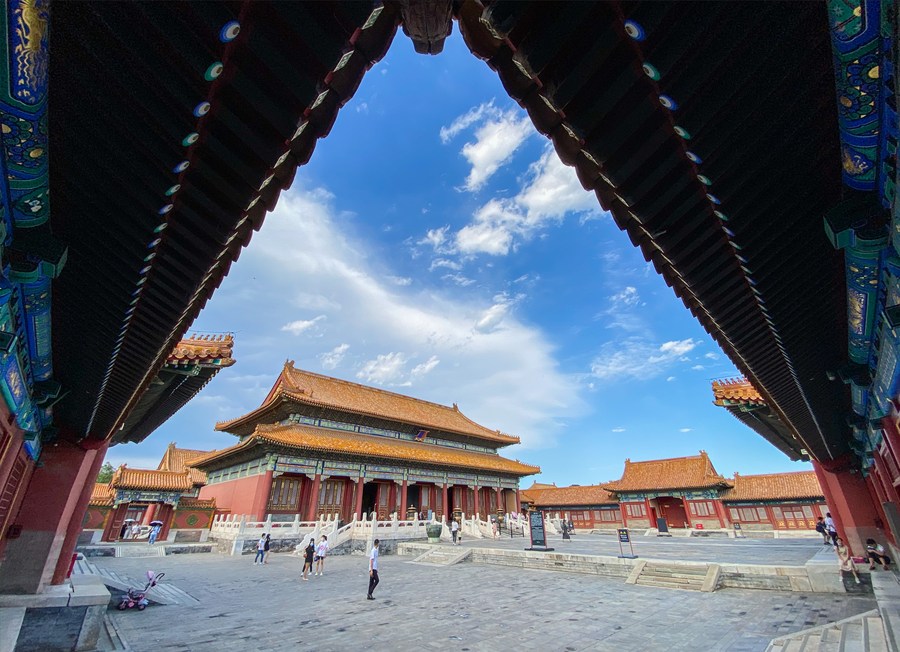
Photo taken with a mobile phone shows a view in the Palace Museum in Beijing, capital of China, Sept. 1, 2020. (Xinhua/Meng Chenguang)
The improved air quality marked a step closer to meeting the level-two national standard for PM2.5 control, which is 35 micrograms per cubic meter.
BEIJING, Jan. 4 (Xinhua) -- Beijing saw more days with good air quality and a record-low average PM2.5 density last year, the municipal environment authorities said Monday.
The average concentration of PM2.5 in the metropolis was 38 micrograms per cubic meter in 2020, a year-on-year decline of 9.5 percent and the lowest measurement since the data was first collected in 2013, according to the Beijing Municipal Ecology and Environment Bureau.
The improved air quality marked a step closer to meeting the level-two national standard for PM2.5 control, which is 35 micrograms per cubic meter. The PM2.5 reading is a gauge monitoring airborne particles of 2.5 microns or less in diameter, which can penetrate deep into people's lungs.
Liu Baoxian, director of the Beijing Municipal Ecological and Environmental Monitoring Center, said that half of Beijing's 16 districts saw their PM2.5 density meet the national standard last year, up from only two in 2019.
Last year, the city saw 276 days with good air quality (which is determined by concentrations of major air pollutants), up by 100 days from 2013, according to Liu. There were only 10 days of heavy air pollution, compared to 58 days in 2013, statistics from the bureau show.
Last year, the average concentrations of PM10 and nitrogen dioxide in Beijing were 56 and 29 micrograms per cubic meter, respectively, both about half the numbers in 2013 when the city was faced with prolonged, severe smoggy weather.
"The air quality in Beijing has notably improved in recent years with far fewer smoggy days," said a 56-year-old resident surnamed Zhang. "I am more willing to do morning exercises outdoors."
In 2013, Beijing's municipal authorities issued an action plan to tackle air pollution amid mounting public concerns, pledging to win the "battle for blue skies" through a spate of measures including the demolition of coal-fired boilers, the optimization of the energy structure, and the phasing out of vehicles with high emissions.
The city's annual coal consumption has dropped below 2 million tonnes, and clean energy now accounts for 97 percent of the city's total energy consumption, according to official data.
As of November last year, the city had a total of 401,000 new-energy vehicles, and over 60 percent of all vehicles in Beijing met the strict "China V" emission standards or above.
Municipal authorities launched a campaign last year targeting volatile organic compounds and dust pollution, according to Li Xiang, an official with the Beijing Municipal Ecology and Environment Bureau.
Li added that big data and other advanced technologies have been used in the efforts for cleaner air. For example, the city has established monitoring platforms for vehicle emissions and dust pollution.
Over the years, Beijing has cooperated with neighboring Tianjin Municipality and Hebei Province to jointly fight air pollution, with positive results achieved.
However, experts say the Beijing-Tianjin-Hebei region and the nearby areas face an arduous task in further improving air quality as the region's emissions of air pollutants still exceed its environmental capacity.
Authorities in Beijing have vowed to advance regional cooperation on air pollution control and further reduce the emissions of carbon dioxide and other pollutants such as PM2.5, ozone, volatile organic compounds and nitrogen oxides in 2021. ■




